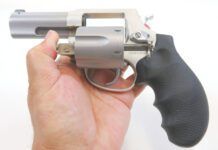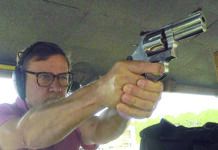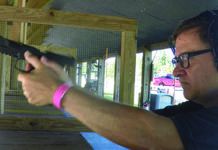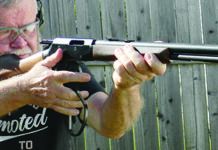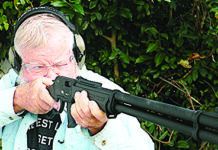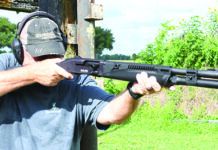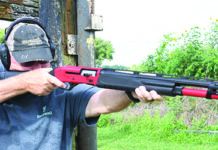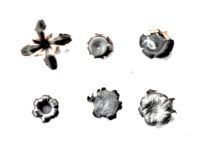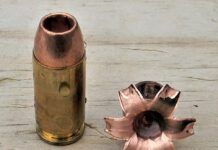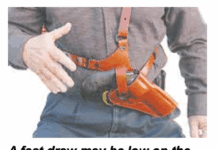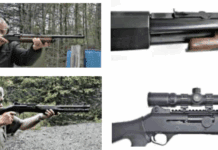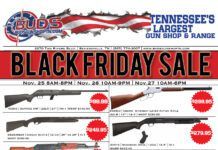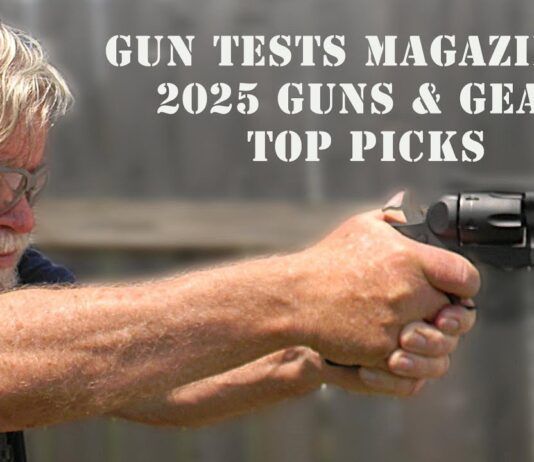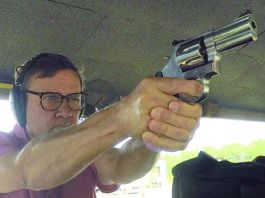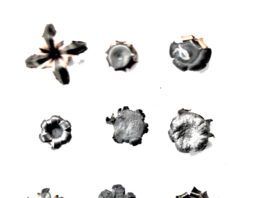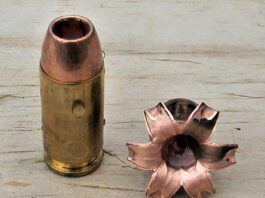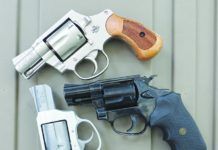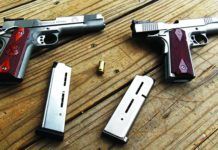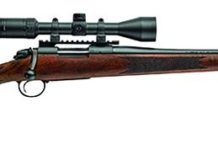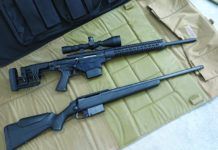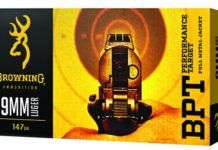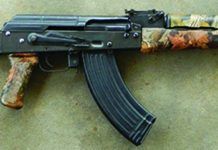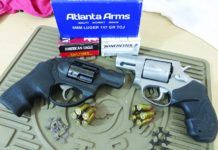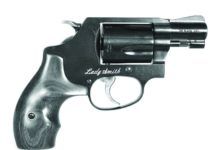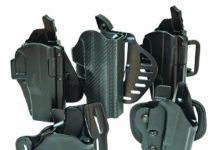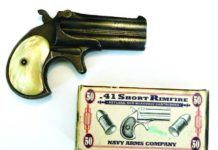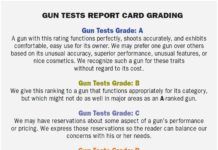$400 Snubnose Revolvers: Rossi, RIA, and Charter Arms
We felt all of these were well made, and we believe these revolvers will perform their designed task of self defense. They are also safe to carry fully loaded and concealed, since they are equipped with internal safety systems that require the trigger to be pulled fully to the rear to fire a round. If accidentally dropped, none of them will fire.
Snubnose revolvers like these three offer the user simplicity since there are no manual safeties, magazine-release buttons, slide stops or any other controls on the revolver other that the cycler latch. There is no magazine to lose since the revolver feeds off an attached cylinder. The double-action trigger pull on all three revolvers provided enough resistance — some were easier to press than others — so that in a high-stress situation, we felt they would be quite adequate and be less likely to be accidentally discharged.
All were metal-frame revolvers chambered in 38 Special and sported 2-inch barrels. The Rossi and Charter Arms models have 5-round capacities, while the RIA can carry 6 rounds. Because we also wanted to carry these revolvers, we looked at spurless and concealed-hammer models, which were the RIA and Charter Arms, respectively. The Rossi was a traditional SA/DA revolver with an exposed hammer with spur.
After running these revolvers, we found we liked a lot about all of them, but, as always, we noted some specific details about them we did not like. Our biggest gripes were the trigger pulls and grips, as we note below. Accuracy with some of these short-barrel protectors was a pleasant surprise.
All three were marked 38 Special, and we read the manuals to see if the guns were safe to use +P ammo. The Rossi manual stated it was compatible with +P ammo, but not to use +P frequently. We decided to test with 38 Special regular-pressure ammunition only, and acquired some Federal Champion 158-grain lead roundnose (LRN) cartridges, some Armscor 158-grain Full Metal Jacket (FMJ) rounds, and Hornady Custom fodder loaded with 158-grain XTP hollowpoints. Felt recoil with this ammunition varied widely.
A $400 revolver will exhibit some characteristics, such as fit and finish, that are not going to be nearly as nice as a revolver costing twice as much because finishing a firearm can be labor intensive and costly. What we concentrated on were the functional aspects: triggers, sights, grips, accuracy, concealability, and ease of use. Here is what we discovered.
Practical Target Guns: Kimber And Springfield Go Head to Head
In this installment, we pit two practical target guns against each other. By practical target guns we mean accurate and useful 1911 handguns suitable for personal defense, hunting, and some forms of competition. They are not so specialized that they are not holster guns or unreliable for general use. Some target guns simply are not as robust as these handguns.
Fragile sights that overhang the slide too far, as an example, are counterintuitive in an all-round packing gun. If an adjustable sight loses its zero in competition, you will lose the match. Losing zero in a personal-defense situation carries a stiffer penalty for failure. Getting down to the nitty-gritty, fiber-optic front sights are not always desirable in a hard-use handgun because they tend to be fragile, even if they deliver superior targeting performance.
On the other hand, a service pistol or a hunting pistol with adjustable sights is desirable given the wide range of bullet weights and velocity available with the 45 ACP cartridge.Gun Testsreaders already know that the 1911 Government Model platform is a versatile, go-anywhere do-anything handgun; but the question is, can target performance translate to defensive reliability and handling?
When the National Matches got into full force after World War One, improvements were undertaken on the 1911 handgun. Barrels were welded up and carefully fitted, and high-profile sights were fabricated. These improvements led to the Colt National Match pistol's introduction in 1933. The National Match featured a hand-honed action and two-way adjustable sights. Law officers and outdoorsmen also adopted this relatively expensive handgun. Changes and modification led to the Colt Gold Cup. The sights were fragile in many renditions — not the case in the newest models — so the shooter wishing to own a service-grade handgun with target sights had to take the custom route. Expedients, such as fitting Smith & Wesson revolver sights to the 1911 slide, were not always successful, but the Bo-Mar sight was an excellent addition to any 1911.
High-visibility adjustable sights are a good thing to have, provided they are reliable in keeping zero, are not fragile, and aren't likely to be damaged. Today, we have the best adjustable-sight 1911 pistols yet from the factory, and our two tests guns put them to excellent use. Here's how they performed.
New Long Guns Coming for 2016
At the 2016 SHOT Show in Las Vegas, Gun Tests staffers ran across many dozens of new products that we're working to include in future tests. Following are some of the rifles, rifle ammunition, shotguns, and long-gun accessories we found interesting. If there's something in particular you want us to test, please drop me a note at GunTestsEditor@icloud.com.
Barnes Bullets has added two new loads to the VOR-TX line of premium ammunition. The first is a 130-grain Tipped Triple Shock load for the 308 Winchester. It is rated at 3,170 fps, and it takes the 308 Winchester into a new realm of velocity. SRP: $45.69 for a 20-round box. The second load is an 190-grain LRX bullet for the 300 Winchester Magnum. This bullet's ogive and cannelure design gives it a high B.C., and the nose cavity engineering ensures it expands reliably at lower velocities. It is rated at 2,860 fps.
The Woodsman rifle is new from Bergara. This bolt-action hunting rifle weighs 7.4 pounds in long action and 7.1 pounds in short action. It has a hinged floor plate and comes with a 22- or 24-inch, No. 3 contour barrel. The stock is American walnut, and available chamberings include 6.5 Creedmoor, 7mm Rem. Mag., 308 Win., 30/06, and 300 Win. Mag.
Browning's biggest shotgun news is that the Sweet Sixteen is back. Like its most revered predecessor, the new A5 Sweet Sixteen is built on a smaller, lighter receiver for reduced weight and a sleek feel. The A5 uses kinetic energy to power the recoil-operated Kinematic Drive System for reliable function with any load and under the full extremes of weather, temperature, moisture, or grime. The A5 16-gauge receiver is constructed of aluminum with a black anodized bi-tone finish. The stock—shim-adjustable for length of pull, cast, and drop—and forearm are gloss finish walnut with a close-radius pistol grip and sharp 18 lines-per-inch checkering. The gun uses Browning's Invector DS choke system; three chokes will be supplied with 2 -inch chambered barrels in 26- or 28-inch lengths. Weight: 5 pounds 12 ounces.
308 Win. Bolt Guns: Rugers Precision Rifle vs. Tikka T3 CTR
We admire long-range competitive shooters for doing something we mere shooting mortals find nearly impossible. Their ability to manage distance, wind, and overly complicated reticles on specialized rifles to deliver hits on targets that can hardly be seen with the naked eye is both an art and science. Usually a precision centerfire rifle is custom-made, costing upwards of $3,000 or more with a wait time that can take years, depending on the popularity of the custom-rifle builder. Adding a suitable optic can increase the cost an additional $1,000 to $2,000, plus bipod and other pieces of gear, not to mention quality ammo. All in, a shooter could easily sink $7,000 into a set up before even sending a single piece of lead downrange.
Firearm manufacturers, seeing the shooting public's interest in long-range shooting, are offering rifles advertised as "tactical" and "precision" to attract long-range hunters and weekend paper punchers. We all know that setting a barreled action in a black polymer stock does not make a precision rifle. But lately, some large firearm manufacturers have begun mass-producing accurate rifles that rival some custom-built rifles without the wait or the high cost. These mass-produced precision rifles can handle many long-range chores, and some of them come in compact lengths and have the ability to add muzzle devices, such as suppressors.
We wanted to take a look at a few of these rifles to get a sense of their accuracy as well as their consistency, ease of use, ability to be customized, and cost. We began looking at such rifles in the January 2016 issue when we compared three bolt actions from Savage, Ruger, and Howa, all chambered in the very accurate 6.5 Creedmoor round. Our favorite in that test was the Savage Arms Model 12 Long Range Precision 19137, followed by the Ruger Precision Rifle 18005 and the Howa HB HKF92507KH+AB. Here we take a second look at the Ruger Precision rifle, this time in 308 Winchester, against a Tikka T3 CTR. The 308 Win. is a common and popular round, with many factory ammunition options available. We tried the spectrum of 308 Win. ammunition and bullet weights, from inexpensive Sellier & Bellot 150-grain soft-point hunting rounds and Norma USA's 168-grain Sierra hollowpoint boattail to expensive 175-grain boattail Sierra MatchKing hollowpoints in the Federal Premium Gold Medal match ammo line, as well as Hornady 155-grain TAP FPDs. Both rifles were fired from a sandbag rest as well as from seated and prone positions. We also made sure the temperature, wind speed, and humidity conditions were similar when we shot these rifles, even though these factors have more affect on targets at farther distances than the distance tested. Barrels were allowed to cool after each string.
Test firing was conducted at 100 yards, though that distance may seem short compared to what these rifles' makers say the products can do. This is the most common rifle-range distance many shooters have access to. Members of this particular test team had experience with high-end SIG Sauer SSG 3000 and Sako TRG M10 and TRG 42 rifles, and numerous chassis-style rifles with Remington, Savage, and custom-rifle-maker barreled actions, as well as long-range hunting rifles like the Savage 11/111 models and Remington Model 700 varmint rifles. A Leupold Mark 4 4.5-14x50mm LR/T scope (Brownells.com, $900, #526-000-150WB) was moved between rifles Warne Maxima-series steel rings to ensure there was no optic variability. The Mark 4 series has been used by the U.S. Marine Corps on the M14 rifle and with the U.S. Army's M24 sniper weapon system. One might consider it to be a benchmark in tactical scopes. It is made with a one-piece 30mm tube and a 50mm objective. The M1 TMR (Tactical Milling Reticle) reticle is located in the second focal plane, so it stays one size even as the magnification power is increased. To use the Mil-Dot ranging features, the scope must be set to the highest magnification. We bore-sighted the rifles prior to starting range work. Here's what our shooters found out at the range.
New Handguns at SHOT Las Vegas 2016
At the 2016 SHOT Show in Las Vegas, Gun Testsstaffers ran across many dozens of new products that we're working to include in future tests. Following are some of the handguns, handgun ammunition, and handgun accessories we were interested in. Next month we'll look at new long guns and new options for them.
Given the growth of the AR-15 pistol market, aftermarket supplier ATI sees an opportunity to help users of the popular Ruger Charger get more enjoyment out of its use. The AR-22 Pistol Stock System features a polymer receiver chassis and a T2 pistol grip as well as a six-sided aluminum free-floating forend that sports an FS8 nose cone. The T2-style pistol grip lowers a shooter's hand to align the finger with the trigger, and the sure-grip texture helps reduce recoil. In addition, the stock also features a 16-inch aluminum Picatinny rail that runs the length of the receiver and forend for trouble-free optic and accessory mounting.
The biggest ammunition surprise might be the news that Browning is now offering, via licensing, a full line of ammunition manufactured by Olin-Winchester.
The BXP Personal Defense X-Point defensive handgun loads are loaded in black nickel-plated cases, with bullets utilizing the X-Point technology. There is also a line of Target Performance BPT loads for defensive handguns. The usual chamberings are represented in both lines, with one load each in 380 ACP, 9mm Luger, 40 S&W, and 45 Auto. Browning is also offering rimfire loads in 22 LR. They have a distinct black-oxide coating on the bullet and will be offered in 100- and 400-round packages.
AK-47 Accuracy
Recently, a Gun Tests reader requested that we gauge the accuracy of 7.62x39mm loads in the AK-47 rifle, with an eye toward evaluating the AK for ad hoc hunting, if the opportunity arose. Many of these rifles are in use in America, so determining the ability of the rifle to humanely harvest a deer or hog seemed like a good idea to check out. The 7.62x39mm cartridge is often compared to the 30-30 Winchester in power, and if the AK-47 and its loads were accurate enough, then the pair could be counted upon to take thin-skinned game at moderate distance.
The question is, how accurate is commonly available ammunition in an average AK-47 at 100 yards? To find out, we obtained an AK-47 from the used rack at a pawn shop. The rifle featured an NDS receiver and seemed well put together. While we were there, we also grabbed an SKS chambered for the same round, in this case a Chinese rifle in excellent condition with matching serial numbers on its parts.
Benchresting the AK and its long magazine produced some difficulties. We found it is not an easy rifle from which to coax accuracy. The SKS was easier to use well off the bench, especially when using the onboard iron sights. After initial sighting work at 50 yards to get on the paper, we fired a succession of three-shot groups at 100 yards, sighting both at the base of an 8-inch bull. At the end, we found the SKS to be slightly more accurate with the ammo we selected.
In broad terms, then, we think most shooters can get commonly available AK-47s to shoot around 4-inch groups at 100 yards, good enough to take game at that distance. We had slightly better results with the SKS, and would think of it as a 3.5-inch gun at that range. Also, we found a few rounds these guns preferred, so if you're attempting to knock a hog in the head, you might consider starting with our winners in your own AK or SKS. Following are our ratings for eight ammunition choices suitable for the AK-47 or SKS variants, and you can also scan the results in the accompanying table.
9mm Luger Snubnose Revolvers: Ruger LCR versus Taurus 905
The 9mm is the most popular handgun cartridge in the world, in use with most military forces and LE agencies; in fact the FBI announced in 2014 that it is switching back to the 9mm after having used the 40 S&W since 1997. When we think snubnose revolvers, we typically think 38 Special, but since the mid-20th century, revolver manufacturers have been building short-barreled wheelguns chambered for 9mm semi-automatic pistol ammunition. In the past we tested two such 9mm Luger chamberings, an S&W Model 940 (C+) and Charter Arms Pitbull (A-). We noted then that 9mm compact semi-automatic pistols have an edge over 38 Special revolvers due to the semi-automatic's higher round capacity, but in the revolver, the playing field between 38 Special and 9mm Luger is leveled, as far as round counts go.
Now, ballistic technology has made the once underperforming 9mm better. We have done a number of tests comparing 9mm and 38 Special ammunition from short-barrel handguns, and, generally speaking, the 38 Special runs bullets with weights from 110 to 158 grains at muzzle velocities of 900 fps to 1000 fps. The typical 9mm uses bullet weights from 115 to 147 grains at speeds of 910 fps to 1100 fps. So the 9mm has a slight performance advantage over the 38 Special. A bigger nod goes to the availability and affordability of 9mm ammo, which can be found nearly anywhere in the world, and which domestically costs about 17 cents a round compared to 25 cents a round for 38 Special.
There are other reasons to look at 9mms in wheelguns. We feel the ability to swap ammo between our semi-auto and our revolver makes sense, with only one type of cartridge to purchase. New shooters usually find revolvers to be less complicated to operate, so if your home-defense backup isn't familiar with semi-autos, you can still partner a high-cap 9mm semi-auto with a low-cap 9mm wheelgun pretty easily.
Though some testers groaned when they saw the 9mm revolvers in this test, saying they were as unnatural as three-wheel motorcycles, they put their prejudices aside and found these revolvers performed well at the range. The Ruger LCR Model 5456 9mm Luger debuted in 2014, and the Taurus 905 has been around since 2003. Unlike the Charter Arms Pitbull (which does not use moon clips, but instead employs a retention spring built into the ejector that fits under the 9mm cartridge's rim), the LCR 9mm and the 905, like the S&W Model 940, use five-shot moon clips. Moon clips have been the standard convention when chambering semi-automatic cartridges in revolvers since 1917, when 45 ACP was chambered in S&W and Colt's large-frame revolvers. Moon clips mean the revolver is fast to reload — nearly as fast as a magazine change in semi-auto. But, as we have found in the past, carrying a spare moon clip in one's pocket can lead to bent clips, making them inoperable. Not that this a show stopper, just an attribute of moon clips in general. So don't put a moon clip in your rear pants pocket and sit down. In fact we loaded both the Ruger and Taurus moon clips provided with the test guns and dropped them onto a concrete floor from waist height to see if the cartridges would fall out or the clips bend. A cartridge from each clip popped out after the drop, but there was no sign of bending. Another cost we looked at was how much moon clips go for.Brownells.comlists three moon clips for $12.99 (#780-001-371WB), less than one semi-auto magazine. The moon clips from Taurus and Ruger were not compatible with the other manufacturer's revolver. We should note that single cartridges can be loaded into the chambers of the Ruger and Taurus wheelguns and fired safely, since the 9mm case headspaces on a step in the chambers. In that case however, extraction without a moonclip requires each case be pushed out with a pencil, pen, or similar skinny object.
Revolvers for the Elderly, New Virginia Laws, Henry Rifles
In last month's Firing Line, reader Winslow asks for advice on a 357 magnum lightweight snubnose revolver for a 75-year-old female cousin. I would appreciate a little help. I'm wondering why these two diametrically opposed 308s were chosen to oppose one another. While I am not in one of the affected states, I am from Vermont, and we do not require a permit for CC, and no state recognizes our not needing a permit! Whatever happened to the personal pride everyone took in their ownership of not only a working tool, but also a masterpiece of design and artwork?
I have read recent Gun Tests articles on various AR rifles, so I recently built an AR with a folding stock. I was attracted to this option because I drive a sports car, and even with a collapsible stock and 16-inch barrel, an AR will not fit in the trunk. The folding stock adapter I chose was one made by Law Tactical (LawTactical.com). It was easy to install, works fine to fold the stock, and adds just a little bit of fiddling when I have to separate the upper and lower. But it is very expensive and adds no additional operating functionality to the firearm, since it should never be fired with the stock folded. Anyway, I have not seen many options for folding stocks on an AR platform, and thought that a review of adapters for them might be in order.
Best Holsters for Handgun Retention, Part 1
Handgun retention is serious business for uniformed police officers who, as a matter of course, practice open carry. Special holsters with retention beyond a tight fit are mandated in most precincts, yet the list of police officers killed with their own guns sadly continues to grow. So what does this mean for civilians who openly carry their firearms? On January 1, 2016 the state of Texas will join the list of states no longer requiring concealed-handgun license holders to carry their weapons concealed. How many Texas CHL holders will immediately change their habits from stealth carry to out-in-the-open carry remains to be seen. Gun Tests doesn't get into how people carry and use their legally owned firearms, but we recognize that some legal gun owners will want to open carry, which creates two issues the shooter has to deal with in advance. Mainly, the gun owner must maintain control of a carry firearm while still having fast access to it.
Joe Woolley, president of Firearms Operations and Responsible Training of Texas (FortTexas.us), thinks the new law might prompt licensees to carry larger firearms that are ordinarily more difficult to conceal. But more important, he said, "The security level of any open-carry holster I use will need to be higher than for the concealed firearm." To see how manufacturers provide this extra security, we assembled a collection of 12 currently available holsters that supply more retention than most concealed models — that is, they require the manipulation of a locking device to draw the weapon. We'll cover this dozen in two parts in back-to-back issues.
Our test holsters were Hogue Incorporated's $50 ARS Stage One Carry, Galco's M4X and M6X each priced at $45, Blackhawk's $79 GripBreak, and the $32 Evader from Bianchi. In addition we tested three holsters from DeSantis, the $52 Facilitator, the $40 Quick Safe, and the $68 Prowler. We also tried a trio of holsters from Safariland, the $50 578 ProFit in Long and Standard sizes and Safariland's $50 6378 ALS. Last, we also tried Blade Tech's $124 WRS Level 3, which was much closer to being a police duty holster than what a civilian would typically wear. In this installment, we'll tackle the Blackhawk GripBreak, DeSantis Facilitator, Galco M4X and M6X, and the Hogue ARS C.
Most people think a tight fit in a typical holster constitutes Level I retention and the addition of a thumb-break strap makes it a Level II holster. That's not actually the case, any more than adding a mechanical locking device would change its rating to Level III. Retention ratings and their corresponding tests were originally developed by Bill Rogers, a former FBI agent and pioneer in modern police training. In purchasing the Rogers Holster Company in 1985, Safariland adopted his security rating system with tests intended to simulate a gun grab. Rogers' Retention Level I test (trademarked) "is described as applying all the force to the grip or handle of the weapon by an individual while the weapon is totally secured in the holster and mounted on a suitable belt being worn by another individual. The direction of force is unlimited, but the duration of the force is limited to 5 seconds. At the end of the 5 seconds, the weapon must still be secure in the holster and the holster must still be attached to the operator." By mounting each holster on a Blackhawk Instructor Gun Belt ($37 fromOpticsPlanet.com) we made sure any failure would be traced back to the holster and not to the belt.
Our tests likely exceeded Bill Rogers' protocol by wrestling to the ground for weapon control. We challenged retention using two types of grips, "educated" and "freestyle." The educated grip describes how an instructor might handle the gun, with the trigger finger held straight alongside the frame with three fingers wrapped below the trigger guard, thumb hugging the opposite side of the pistol. The freestyle grip started with all four fingers beneath the trigger guard and thumb wrapped around the other side. We also tried grabbing the gun with the left hand from a right-hand-side-mounted holster. In the interest of security, we're not going to tell you everything we learned about drawing from these high-retention holsters — just whether or not they might help protect you from a gun grab.
Derringer Shoot-out: DoubleTap, Cobra, American Derringer Co.
Meet the derringer, an anomalous little pocket pistol of which there are many types. Gun Tests tested 3 of these handguns to see if they are worth the purchase. Turns out, they might be better for show than for showdown. The original derringer was a product of one Henry Deringer, a 19th-century maker of small muzzleloading pocket pistols. His original Philadelphia Deringer percussion-lock pistols were usually 41 caliber and varied in length from 1.5 to 6 inches. The most notable use of a Deringer was by John Wilkes Booth, who shot President Abraham Lincoln. Once cartridge guns came into being, Deringer's name was misspelled often enough to become the generic description of a small pocket pistol of limited capacity, often with a sliding or pivoting breech block. They commonly carried two shots, although some were designed for up to four shots. They were sometimes called "muff pistols" because they were carried in a muff or hand warmer used in the winter. Also, the derringer became a backup favorite of Western marshals and outlaws alike.
Among the most successful of these handguns was the Remington Derringer. In fact, the Remington's profile is associated more with the derringer than Deringer's original single-shot black-powder pistol. The Remington doubled the payload with twin barrels in the over-and-under fashion. The Remington barrels pivot upward to load and unload, and a pivoting cam on the firing pin fired first one barrel then the other. The Remington Derringer was made of iron, never steel, and was manufactured from 1866 to 1935. That is a long run for a relatively primitive handgun. The .41 Short Rimfire it fired was no powerhouse, exiting the Remington barrel at 425 fps. There have been many copies of the Remington, and two of the pistols tested in this report are copies of the Remington, namely the Cobra Enterprises CB9 Big Bore Derringer 9mm Luger, $151; and the American Derringer Company Standard Model 38 Special, which we bought used for $212. The third gun in the test was a new take on the derringer concept, the DoubleTap Defense Tactical Pocket Pistol in 9mm Luger, $499 MSRP and a $345 counter price from Cheaper Than Dirt!
The derringers were all easy to carry well, and the balance and flat profile make for a nice pocket or vest pistol. However, after testing both the derringer concept and the individual derringers, we think the money spent on these handguns would be better used elsewhere. But we graded on a "derringer" scale relative to each other, even though none of our test shooters would buy one. Here's what we found.
Within Range of California Gun Laws
See reader feedback on pistols, rifles, handguns and more! Reader John S. took our list of 380 ACPs to his local gun store in the Golden State, but his results were far from golden. Mare's Leg pistols are in fact legal for sale in California. Not all home building materials take bullets equally. And pistols that look like rifles. Lots of them.
Handgun Bullets: How Do They Penetrate in Home Materials?
An important consideration in home defense is the prospect of the penetration of a wall by an errant projectile. The primary objective in a defensive situation is to destroy tissue that is vital to the adversary's mobility. Only when an object or projectile strikes vital neural pathways (brain, spine, some nerve groups) or major blood pipelines (heart, lungs, some arteries and veins) that cause rapid blood loss will the pressurized system of the human body shut down. The primary responsibility of the home defender is to strike the target. Letting go with a round when you do not have a reasonable expectation of hitting the target isn't a responsible action. Still, being human, we may miss the target, so it's wise to know what a projectile (bullet, slug, or shot) may do when it connects with common building materials. Also, besides being responsible for every round we shoot, one of the raters in this test pointed out that the defensive shooter may also like to know what he can expect of materials that might hide or protect him if he or a loved on is under fire from an intruder.
To find out how handgun projectiles reacted to impacts on various materials, we first fabricated wall segments with commonly found wallboard and pine boards, then fired a few hundred rounds of ammunition to destroy the structures. At the end, we came up with common-sense recommendations that can solve the problem of overpenetrating handgun bullets that might be used in home defense. Remember, these tests cannot be compared to the FBI test program. The FBI was looking for penetration. That agency needed loads that would reasonably be expected to penetrate light cover and still strike a heavy blow. We were looking for handgun loads that don't meet the well-known FBI penetration criteria.


